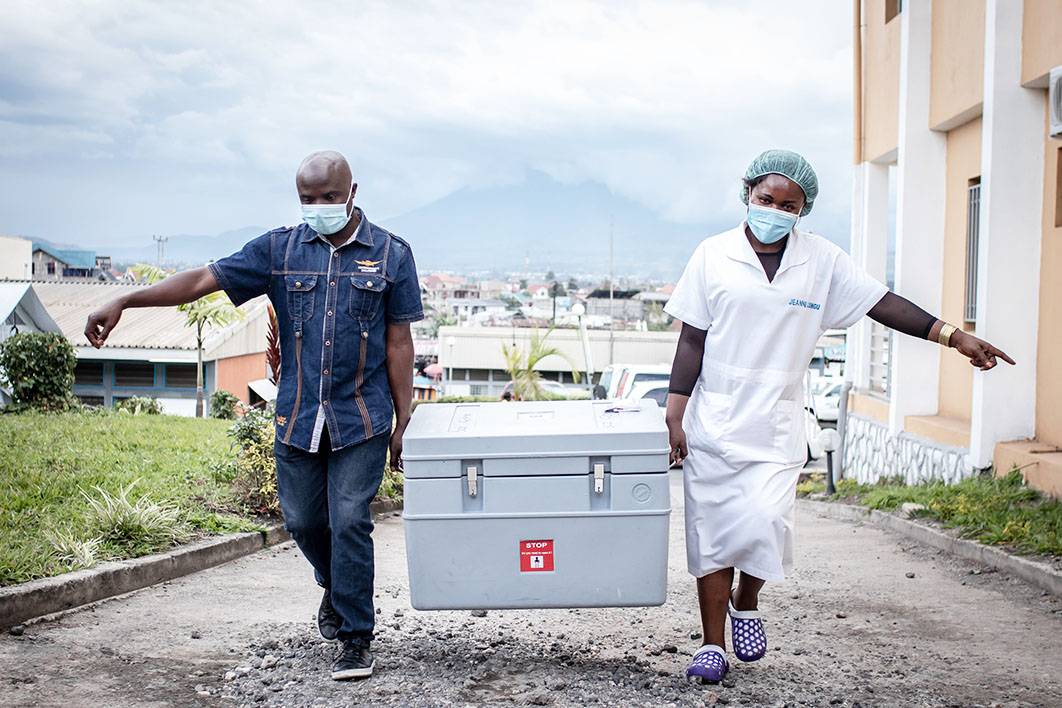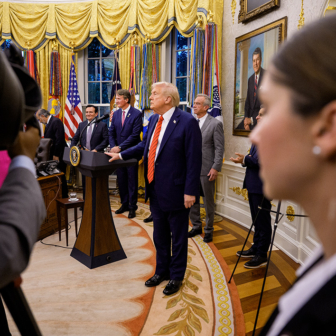Covid-19 has taught us many things about the world, and among the most concerning is that access to vaccines of all kinds is vastly unequal. We now know — as we should already have known — that a “prevention divide” means citizens of Australia and other wealthy countries are vaccinated much faster and more surely than their counterparts elsewhere around the globe. And we’re starting to realise that this is bad not only for people in developing nations but also for those of us in the developed world. The jab divide leaves everyone unsafe.
As of 9 September, only 2 per cent of the population of low-income countries had received at least one vaccine dose. In lower-middle-income countries the figure was 30 per cent, in upper-middle-income countries a slightly more respectable 54 per cent, and among high-income countries 65 per cent. Not one low-income country had met the World Health Organization’s target of vaccinating at least 10 per cent of their people.
The averages hide more shocking disparities. While more than 80 per cent of Australians, Portuguese and South Koreans are fully vaccinated, many governments are struggling to get first doses to even half of their population. In the poorest nations — countries like Haiti, Yemen, Sudan and the Democratic Republic of Congo — less than 1 per cent of the population have had even one dose.
Despite these obvious shortfalls, the British healthcare research company Airfinity calculated in September that rich countries had surplus supplies of more than 500 million shots, even taking account of their planned booster programs, and that the figure is likely to rise to 1.2 billion by the end of the year.
An analysis by the Financial Times shows that rich countries have given out more booster shots in the last three months than poor countries have administered in total doses all year. If those surplus vaccines aren’t sent to the countries most in need, as many as 2.8 million lives could be lost this year.
Epidemiologists are concerned that the current vaccination pattern will prolong the pandemic and create an opening for more dangerous and transmissible variants. The OECD sees inequalities within and between countries escalating, recovery of the global economy slowing, and international travel and tourism continuing to be affected.
An International Chamber of Commerce study found that the global economy stands to lose as much as US$9.2 trillion if governments fail to ensure low-income countries have access to vaccines. Up to half that impact would fall on advanced economies themselves. Even the US intelligence agencies are worried: their latest annual threat assessment concludes that the financial and humanitarian crises experienced by some hard-hit developing countries will increase the risk of internal conflict, government collapses and migration.
How did we get to this point? The course of the pandemic provides part of the answer. It initially fell hardest on high-income countries, which very quickly made early purchase bids for vaccines at prices largely governed by the market. Some countries (the United States, Britain, Canada and eventually Australia) purchased enough vaccines to cover their populations several times over. The G7 countries as a whole, home to just 13 per cent of the world’s population, have purchased more than a third of the world’s vaccine supply — including almost all the current mRNA production from Moderna and Pfizer/BioNTech.
In response to the demand, vaccine manufacturers set their official prices in a variety of ways. Larger, established companies like Janssen (the vaccine manufacturing arm of Johnson & Johnson) and AstraZeneca pledged to market vaccines at no profit during the pandemic. Pfizer’s CEO said the company planned to price for a marginal profit. Novavax plans to make an appropriate return. Newcomer Moderna priced to generate a profit.
In reality, vaccine prices are a movable feast, deeply dependent on quantity, negotiating capacity and demand. UNICEF, the UN children’s fund, has found that many middle-income countries are paying as much as high-income countries, if not more. Researchers at Oxfam calculated that Pfizer/BioNTech and Moderna received US$100 billion of taxpayers’ money to fund research, development and early purchases of their vaccines, but are charging up to twenty-four times the cost of production, and rising.
The AstraZeneca jab is seen as the cheapest of the main Covid-19 vaccines. That might be true in Europe, where the company’s contract with the European Union specifies just US$2.15 a dose, but not elsewhere: the British Medical Journal reported earlier this year that South Africa had paid AstraZeneca US$5.25 per dose for 1.5 million doses to be administered to healthcare workers.
We might all agree that being vaccinated during a pandemic is a humanitarian entitlement, but international action so far has been driven just as much by a concern among Western powers that Russia and China have more successfully pursued vaccine diplomacy with vulnerable nations.
China boldly declared its Sinovac and Sinopharm vaccines to be a “global public good”— as opposed to a commercial product — and has supplied them to some sixty countries, in many cases at no cost. This effort seems intended, at least partly, to undercut purchases already made from Western suppliers but not yet delivered.
But now, with the Chinese vaccines displaying lower efficacy, many of the countries that have used them face a public health dilemma.
COVAX, a global hub for buying and distributing vaccines created by the World Health Organization, the Coalition for Epidemic Preparedness, UNICEF and Gavi, is designed to help countries that would otherwise struggle to negotiate affordable vaccine purchases. It uses funding from governments and donors such as the Gates Foundation to make its own contracts with vaccine manufacturers and deliver supplies where they are needed.
Despite the grand vision, COVAX is 500 million doses short of its vaccine distribution goals. Its aim was to distribute at least two billion doses, two-thirds of them to lower-income nations, by the end of 2021. But only 16 per cent of contracted doses have been delivered, and the two billion doses target has been pushed out a year.
COVAX has struggled for several reasons. Prime among these is the “vaccine nationalism” of high-income nations, which have been slow to meet their commitments to the hub. Though billions of doses have been promised, actual contributions have been paltry, and too often they are small donations of soon-to-expire doses made at the last minute.
Australia is a case in point. The federal government promised A$130 million to COVAX, of which only A$44 million has so far been provided. It promised forty million vaccine doses from the national stockpile and a further twenty million doses for countries in Southeast Asia and the Pacific by the end of 2022. To date, fewer than five million doses have been supplied to developing nations.
In fact, Australia seems to be taking as much as it is giving. The Nine newspapers have revealed that the federal government has bought at least 500,000 Pfizer doses from COVAX to boost local supplies, and the government’s own figures show that it has a A$123 million option to purchase a total of twenty-five million doses for Australian use.
COVAX had hoped that the Serum Institute of India, the world’s biggest vaccine manufacturer, would boost its stockpile, but when Delta infections grew in March this year the Indian government limited exports in order to supply the domestic market.
Around eleven billion doses are needed to fully vaccinate 70 per cent of the world’s population. More than six billion doses will have been administered by the end of this year, leaving a deficit of about five billion doses. A majority of people in the lowest-income countries will wait another two years before they are fully vaccinated.
The problems with COVAX have led policymakers to consider other approaches. Longstanding calls to increase vaccine manufacturing within less well-off countries — extending back to well before the pandemic — have grown louder, with a variety of approaches under discussion. Global health advocates argue that vaccine production must spread beyond the current concentration in the United States, Europe, India and China, not just to tackle this pandemic but also to be ready for future viruses.
A group of countries led by South Africa and India called last year for the World Trade Organization to issue a waiver of intellectual property protections for Covid vaccines. More than one hundred Nobel laureates and seventy-five former heads of state added their support in April, calling on US president Joe Biden to suspend vaccine patents in order to “expand global manufacturing capacity unhindered by industry monopolies that are driving the dire supply shortages blocking vaccine access.”
Despite Biden’s support, the proposal has encountered fiery opposition from the pharmaceutical industry. Vaccine companies say they are already expanding production and the move would have little if any practical effect. Even if they had the formulas, few countries have the trained personnel needed to produce Covid-19 vaccines, and supplies are already stretched.
The World Health Organization has asked innovating firms to contribute their intellectual property to the UN’s Medicines Patent Pool, and proposes a role for itself to coordinate technology transfers, facilitate training, help countries organise the necessary investments in factories, and assist with regulatory approvals and agreements on royalties.
In April the African Union’s Centres for Disease Control and Prevention announced an ambitious plan to establish new vaccine factories with the aim of reducing the continent’s reliance on vaccine imports in general. A push is also being made for an mRNA vaccine manufacturing hub in South Africa. Moderna has indicated it is opposed to patent waivers; now it seems that South African researchers, with WHO support, will attempt to create their own mRNA vaccine using reverse-engineering techniques.
In a recent article in the New York Times, experts in vaccine development and production say that manufacturing mRNA vaccines in developing countries is feasible. Despite resource and timing issues, this approach would give countries the capacity to vaccinate against not just Covid-19 but a whole range of other infectious diseases endemic to low-income countries.
American economist Alex Tabarrok is among those who have argued that patents are not the major obstacle to the current vaccine supply problems. A patent waiver might be largely cost-free for rich countries, he says, but would do little to relieve supply shortages or make distribution fairer. “Sorry, there is no quick and cheap solution,” he writes. “We must spend… Bottom line is that producing more takes real resources not waving magic patent wands.”
Regardless of the force of that argument, two examples highlight why local manufacturing will be vital in the medium to long term. First, the cost of the WHO-recommended vaccine program for children under two years of age — which was set before the pandemic and currently includes eleven vaccines — has been skyrocketing. By 2020 the cost was estimated at between US$37 and US$101 per fully vaccinated child. These important childhood vaccination programs could become unaffordable, especially with the economic fallout of the pandemic.
Second, important newer vaccines — the vaccine against the human papillomavirus, the causative agent of cervical cancer, for example — are already out of reach for many low-income countries. Every year, more than 300,000 women die from cervical cancer, mainly in low- and middle-income countries; nearly all those deaths are preventable by vaccination.
Although the pharmaceutical industry is frequently — and often justifiably — portrayed as purely profit-oriented, the major companies have made efforts over the past decade to support “open source” models of production. These schemes have generally focused on the neglected tropical diseases that receive little research and development funding despite affecting a significant proportion of the world’s population. Could more be done to encourage this approach?
That such hopes are not overly optimistic is indicated by last week’s announcement that US-based pharmaceutical giant Merck has reached an agreement with the UN Medicines Patent Pool to license the international manufacture of its potentially lifesaving antiviral drug molnupiravir for treatment of Covid-19 in adults. This move is expected to create broad access for its use in more than one hundred low- and middle-income countries.
According to the announcement, the three patent holders, Merck, Ridgeback Biotherapeutics and Emory University, “will not receive royalties for sales of molnupiravir under this agreement for as long as Covid-19 remains classified as a Public Health Emergency of International Concern by the World Health Organization.” Many will be watching for signs of other companies following Merck’s lead.
Back in Australia, meanwhile, the End Covid For All campaign last month released a report urging the federal government to lift its commitment to the global vaccination effort by A$250 million in funding and twenty million extra vaccine doses. The group’s Tim Costello urged Australia to “become a vaccine factory for the region.” Help is needed with testing, supplies, transportation and vaccination efforts to ensure these donations deliver benefits effectively and efficiently.
Covid-19 vaccines are a precious resource. Australia needs a plan to ensure it plays its role internationally in making sure vaccinations are managed fairly, without unnecessary price spikes, hoarding or wastage, in recognition that no country is safe until every country is safe. •




